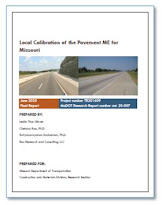The Missouri Department of Transportation (MoDOT) was one of the early adopters of the Mechanistic-Empirical Pavement Design Guide procedure and completed the local calibration using the research grade software in 2009. The emphasis then was on establishing testing and field data collection programs, and calibrating for new designs, as adequate performance data was not available for rehabilitation sections. Since its adoption by the American Association of State Highway and Transportation Officials (AASHTO) and its support for the AASHTOWare Pavement Design ME, several enhancements have been made. MoDOT has made changes to the materials program by increasing use of recycled materials and adding advanced testing capabilities to develop Level 1 materials inputs to the Pavement ME Design procedure. These factors bring to fore the need for recalibration of Pavement ME Design distress and IRI prediction models for Missouri. This study aimed to recalibrate distress models for new and rehabilitated flexible and rigid pavements using Version 2.5.5 of the AASHTOWare Pavement ME program.
This study included calibration sections in Missouri from MoDOT’s pavement management system (PMS) and from the Long-Term Pavement Performance (LTPP) database. Sections covered a range of subgrades, layer material types, thicknesses, climate, traffic, designs, and rehabilitation practices typical for MoDOT. For flexible pavements, New AC, AC over AC, and ACover JPCP designs, and for rigid pavements, New JPCP and Unbonded overlays were considered. Distress models calibrated include Alligator Cracking, Alligator Reflection Cracking, AC Thermal Cracking, Transverse Reflection Cracking, AC Rutting, Total Rutting and Smoothness/International Roughness Index (IRI) for flexible pavements and Transverse Cracking, Transverse Joint Fault, and IRI for rigid pavements. Level 1 laboratory and field data were used for most design inputs. The predictions showed a deviation from global models and therefore we calibrated to reduce error and eliminate bias in all flexible pavement models considered. Sensitivity analyses were used to study the impact of critical parameters. The rigid pavement sections did not exhibit adequate distress development to warrant a recalibration. Until further distress data is collected, the global models are recommended for rigid pavement designs. The study recommends the use of Level 1 field data for future design.
VIEW FINAL REPORT
Report number: cmr 20-007
Published: June 2020
Project number: TR201609
Authors: Leslie Titus-Glover; Chetana Rao, Ph.D.; Suriyanarayanan Sadasivam, Ph.D.
Performing organization: Rao Research and Consulting, LLC

No comments:
Post a Comment
Note: Only a member of this blog may post a comment.